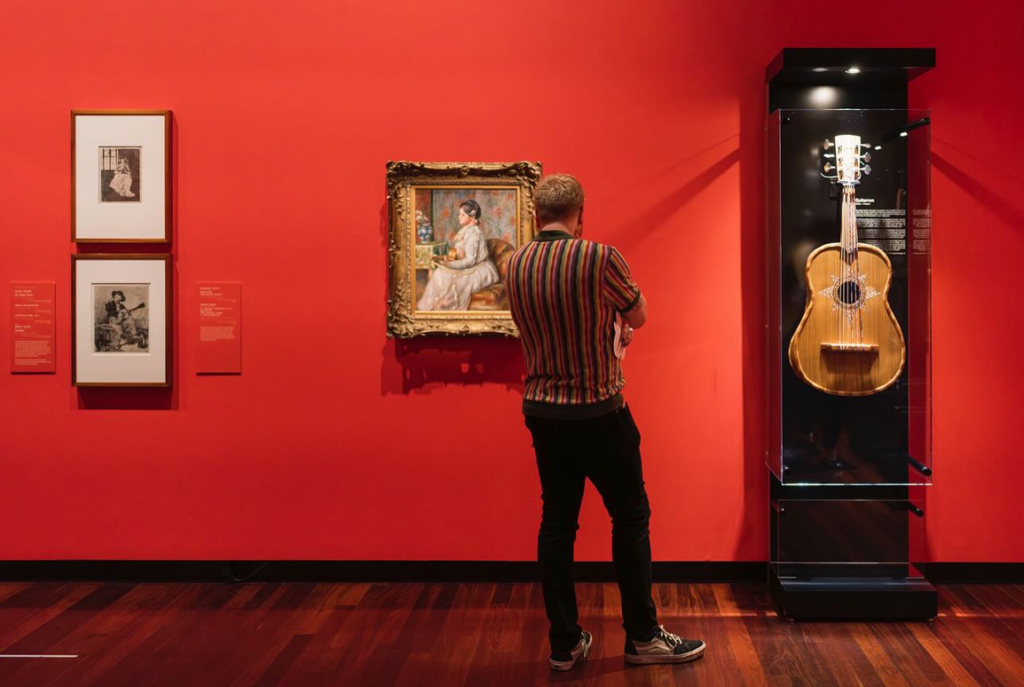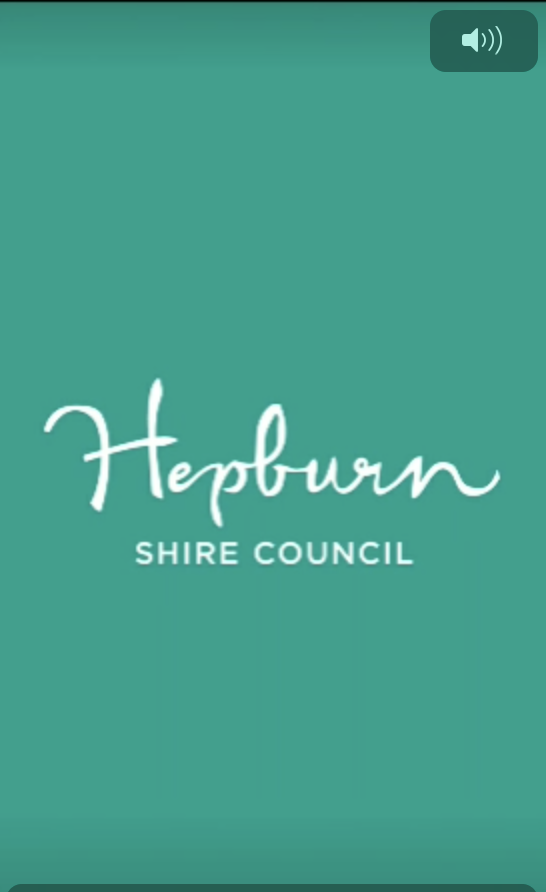October 19th, 2024Medieval to metal: new guitar exhibition strikes a chord

Exclusive to the Art Gallery of Ballarat, Medieval to Metal features more than 300 works, including 40 iconic guitars on loan from the National GUITAR Museum (USA) alongside an awe-inspiring assemblage of photographs, paintings, drawings, illustrative designs, and objects.
The new exhibition really appears to have been striking a chord with art and music lovers alike since it opened in recent days – and will now run through to February 2.
From medieval beginnings through to the guitar’s pivotal role in pop culture, the exhibition includes a collection of music-inspired masterpieces from Australian institutions and newly acquired works in the Art Gallery of Ballarat collection, representing almost two centuries of music symbolism in culture and art.
One for guitar nuts and musos as well as art lovers of all ages, Medieval to Metal: The Art & Evolution of the Guitar features photographs, paintings, drawings, illustrative designs, and objects
from the gallery’s collection alongside the iconic guitars.
The exhibition tracks the instrument’s medieval beginnings as ouds and lutes, to its current role in
society, with guitar makers and luthiers using different shapes, materials, accessories, and designs over time.

September 11th, 2023Art Gallery of Ballarat visitation on the rise

There has been a significant rise in visitor numbers to the Art Gallery of Ballarat, showing a positive trend in audiences returning post COVID.
Newly released figures show that during the 2022/23 financial year, the Art Gallery of Ballarat had 113,734 visitors, averaging 9,479 visitors per month.
The annual visitation represented a 33 percent increase on the previous year and indicates the gallery is well on the way to getting back to pre-COVID visitation levels, when almost 190,000 visitors were recorded in 2018/19.
The Art Gallery of Ballarat Shop also achieved a significant increase in revenue in 2022/23, recording a 32 per cent increase in revenue on the previous financial year.
City of Ballarat Councillor, Cr Mark Harris praised Gallery Director Louise Tegart and the entire team of staff for their hard work and outstanding results.
“The Art Gallery of Ballarat is such an incredible asset for the entire city and to see it performing so well is a justification of all the crucial background work over many years,” he said.
“The programming that we saw in 2022/23, most notably our collection exhibition Beating about the Bush showcasing Australian impressionist paintings and contemporary photography and the paired exhibitions Pre-Raphaelites: Drawings & Watercolours and In the Company of Morris, were both an outstanding success.
“It’s an exciting time for the gallery and the future is looking very bright with a new strategic plan also underway.
“I’ve been told that what is motivating the gallery team now is how much more can be done with this work already completed. There are exciting plans for the years to come.”
Highlights from the 2022/23 financial year included:
- Pre-Raphaelites: Drawings & Watercolours and In the Company of Morris: The Pre-Raphaelites was a touring exhibition from the Ashmolean Museum, Oxford. It was presented in Australia exclusively by the Art Gallery of Ballarat. In the Company of Morris showcased an exhibition of historical and contemporary Australian artworks demonstrating the influence of the Pre-Raphaelites and in particular William Morris. Both exhibitions were run concurrently.
- Partnership with multiple City of Ballarat events: including the Skywhales launch at the Eastern Oval for the 2022 Ballarat Winter Festival; an Art Gallery of Ballarat outreach activity in the Botanical Gardens for the Ballarat Begonia Festival; hosting the launch of the Be Hear Now music festival and presenting a series of events for the Ballarat Heritage Festival. The Art Gallery of Ballarat also partnered with the City of Ballarat Early Years team to present an outdoor Family Day and Ballarat’s Biggest Playgroup 2023.
- A $50,000 grant through the Department of Transport’s Flexible Local Transport Program: The grant program helped address issues preventing those in regional and remote areas from attending the Art Gallery of Ballarat. The funding enables the gallery to host students from schools that don’t usually have the resources to travel for a gallery visit. During 2022/23, the scheme brought in 527 participants from 21 schools from Western Victoria, who travelled a total of 2,648km with an average cost of $1,151.09 per trip and program continues into the current financial year.
The Art Gallery of Ballarat is currently a key venue for the Ballarat International Foto Biennale 2023, presenting the high-profile international exhibitions People Power – Platon and Instant Warhol exhibitions as well as five other exhibitions, including of works by local Ballarat artists.
May 11th, 2023Artists of the Central Highlands
with Eve Lamb

HEPBURN Springs artist Lisa Gervasoni is renowned for her imposing abstract landscape works. As a child she was fascinated with geographical and street maps. Her passion for cartography persisted into adulthood informing her preoccupation with land and the many layers of value it holds. Today this abiding interest informs both her professional work as a strategic and town planner and the creation of her imposing art works, some of which are about to feature in her new exhibition, Reimagining our Cultural Landscapes, held from today, May 11 to June 25, at the Art Gallery of Ballarat.
Eve: What is your artistic style?
Lisa: Abstract landscape, predominantly aerial or aerial oblique viewpoint work with a Fauvist colour
palette and using paint or thread. I’ve always enjoyed art and I have a sister who’s an art teacher and a mother who’s a master decouper. Traditionally I’ve worked more in thread and photography, but I
went back to painting during lockdowns. I was inspired by Jackie Case and her book Flying Penguins to start painting again.
Eve: Who has influenced your work?
Lisa: Von Guerard. He painted so many places that are important to me. The Impressionists and the fauvists. Grace Cossington Smith, Sybil Craig, the Hermannsburg School, Fred Williams and Peter Tyndall.
Eve: What is your medium and subject matter of choice?
Lisa: A mix of acrylics on canvas or board, thread on linen. And landscapes. I’ve always had a close connection to Australian landscapes through family connections, as a student of geography and then as a heritage planner. People have strong connections to place. While places will change and evolve this change can cause discord within the community and break intergenerational connections to place. I saw this through my work and in our local community after the changes to Hepburn Mineral Springs
Reserve. People would be looking for the places they, or their parents, came to on their honeymoon or as children, and although these places still existed the place no longer held that connection through time. My exhibition is inspired by that idea. Some views remain. Others have completely changed but you can still see connections on close examination.
Eve: Do you work outside your arts practice?
Lisa: I work full-time outside the arts. I have qualifications in applied science (planning) and environmental studies and I’m into my fourth decade as a planner. As a child I loved the Melway. I knew all the maps so my family were not surprised when I became a planner. The cartographic symbolism in my work also stems from that way of seeing different elements or layers in a landscape. Over the last few years I’ve also
seen the failure of many professions, including my own, to understand farming and
farmland. Productive land is valued in the UN Sustainable Development Goals but too many people see it as vacant land where they can do anything without impact. That tension inspired one work in particular.
Eve: What are you working on at the moment in your current arts practice?
Lisa: I’m currently focused on getting everything ready for the exhibition in Backspace at the Art Gallery of Ballarat. I have several other works planned, both on canvas and in thread. One work that I didn’t complete for this exhibition I really want to start next. I invited a colleague to the exhibition and found out she has links to the subject. She was a stalwart through the months after Black Saturday and a
champion for better understanding of social license and agricultural impact
Eve: When you work in the studio do you like to play music and if so what is your
music of choice?
Lisa: I used to play and study music (piano, saxophone, voice, theory) so I have an eclectic taste in music – from Gregorian chant through to punk rock. Safer to say what I don’t listen to – Rod Stewart and Fleetwood Mac. I often have news radio or TV on as well.
Eve: What are your career highlights as an artist?
Lisa: I won the lovely Madi McCrystal’s Daylesford Small Art Prize many years ago (with an embroidery of the Savoia Hotel) and was a finalist in the Harden Art Prize last year. My photographs have been in several galleries as part of 40 works nationally selected by the ABC and one year one of my photographs was chosen as the managing director’s corporate Christmas card. One highlight is curating an exhibition at Warrnambool Art Gallery that looked at local people who shaped the city, or wider, from builders to Nobel Laureates and a lot in between.
Eve: What are the challenges for artists today?
Lisa: Well, I have a full-time job that helps pay for the equipment, and I think that is common to most. Most art needs time. A work that might challenge you initially can end up becoming a favourite when you spend the time to engage with it. I’m lucky to have a trained art teacher as a sister. She has no fear in challenging me to evolve or resolve.
Eve: And the main rewards?
Lisa: Art is an expression. It is a great way to start to switch off the analytical brain, but at the same time you often resolve issues while the other side of your brain is switched on. I think that is quite important for me. It helps deal with work that can be quite stressful but also keeps open those neural pathways that are looking at the big picture, at the connections in the detail and how it all fits together.







